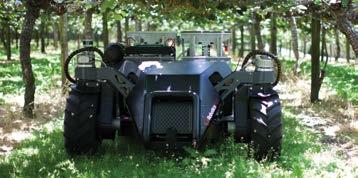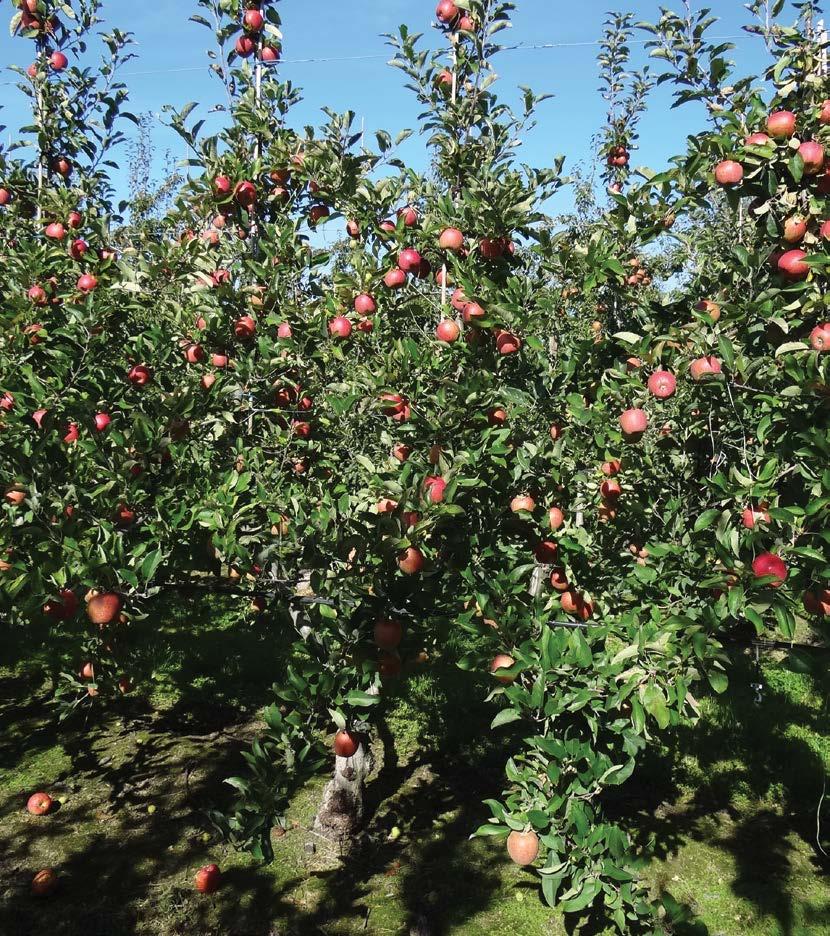
6 minute read
Ahuwhenua Trophy Field Day

2


4
Robotics Plus UGV, 2 Robotics Plus Āporo Apple Packer, 3 Apple Sorter, 4 GreenTech WeedSpider
Automating the future
Accessible horticulture automation is set to solve local challenges by going global.
Supplied by Callaghan Innovation
What is stopping New Zealand from becoming a world leader in horticultural automation technology?
Answering that question, then building the strategy, connections and services to overcome them is behind a new industry-wide initiative that is bringing growers, researchers and commercialising companies together. The Horticultural Automation Initiative is led by the government’s innovation agency Callaghan Innovation. Now in its early discovery phase, the initiative aims to facilitate better collaboration between New Zealand’s researchers, inventors, and commercial operators in horticultural automation and robotics. The goal is to build a strong horticultural automation industry that will become a key economic contributor to New Zealand’s Covid-19 recovery by benefiting local growers while addressing global challenges. In the Agritech Industry Transformation Plan, released in July this year, horticultural automation was identified as one of several key projects with the opportunity to make a significant impact on the industry in a short period of time. “Technology is evolving fast and bang for our local R&D dollars if growers, researchers and commercial hi-tech companies come together. Horticulture Automation Initiative.” Growers are represented in the Initiative by members The Initiative is still in its early formative stage, with a business case being developed by a core group of initiative’s potential impact is high.
Simon Yarrow, group manager agritech for Callaghan Innovation, says New Zealand already has many of the building blocks in place to build world-leading horticultural automation technology. “This country already has a strong reputation for the quality of our high-value food products. What is less known internationally is some of the technology that sits behind those products, from breeding, genetics and growing systems to automated systems that support fast, efficient harvesting, sorting, packing, monitoring and transportation.
Table 1: Opportunity for this initiative to create more high-value jobs in the horticulture sector
NZ $45,565* Average salary for a farm worker in NZ
NZ $91,020** Average salary for a worker in the agritech sector in NZ
Source: * https://www.payscale.com/research/NZ/Job=Farm_Worker/Salary ** TIN Report – NZ Agritech Insights report 2020
“The role of the Horticulture Automation Initiative is to work with and support those who already have the expertise and technical capability, and turn it into an industry that benefits local growers and opens up new international markets by solving global problems,” Simon explains. While sustainability and yield security present challenges for growers, the largest problem they face worldwide is a labour shortage – only compounded by the closure of international borders in 2020. This is where increased automation can make a huge impact on growers’ efficiency and their bottom line.
There are a number of key players from New Zealand which already have strong global successes in this area. Waikatobased BBC Technologies exports automated packing and sorting machines for small soft fruits such as berries, and is about to build a new R&D centre. Robotics Plus builds automated apple packers and is developing several unmanned ground vehicles for horticultural use. It is also working with Waikato University on an automated asparagus harvester, recently tested by growers in the Doesn’t absorb moisture which makes it the
United States Manawatu’s GreenTech supplies US growers with seeding and harvesting technologies and is developing a weeding machine. Simon says the Horticulture Automation Initiative wants to work with the key players such as these, to spread the capability and build a fully functioning agritech automation ecosystem. Some of the local benefits of that would include higher-value jobs (see Table 1, above) and increased export revenue. For New Zealand growers the benefits of greater collaboration should mean better accessibility to technology that is currently often too expensive to be viable. “Growers are the users, investors, testers and enablers in tech, but often don’t want to be – or don’t have capacity to be – the commercial owners.” On the other hand, he technology companies to understand the problems they’re trying to solve, and how to commercialise the solutions. automation is expensive to develop. There is an opportunity to get a better That will be a key function of the
Simon Yarrow
of HortNZ, Zespri, and T & G Global. Wider industry workshops and other forms of engagement are being planned. growers, researchers and commercialising companies with Callaghan Innovation, but optimism about the “If we can grow and scale capability in agritech then we also fuel greater productivity, solve challenging labour issues, strengthen hi-tech exports whilst giving New Zealand’s primary industry a hi-tech productivity boost,” Simon Yarrow says.

SPRAY FOAM INSULATION:
Fills the gaps of older buildings to create an air seal that keeps cold in.
says, researchers need to work with growers and the perfect choice to keep your produce dry & fresh all year.
Actually increases the structural stability of your old shed or farm building.
WHAT THAT MEANS FOR YOU:
Cut out the costs of building a new facility or off-site lease charges
Protect your harvest from the rapidly fluctuating temperatures of the New Zealand climate
Keep your produce fresh on-site until it heads off to the market and tables of kiwi families
TECHNICAL
THE LATEST INNOVATIONS AND IMPROVEMENTS
Critical husbandry tasks

Page 47
Above and left: To avoid lower tree shading, leaders need good support to maintain them in a vertical position

Orchard husbandry priorities
Labour requirements on the orchard will be ramping up, so with the likelihood of skilled labour shortages it will be necessary to set priorities for which husbandry tasks are critical to bringing home a successful crop at harvest and give a low priority to the ‘nice to do’ ones.
By John Wilton : Deciduous Fruit Specialist, AgFirst Dazzle®, Scilate and short-stemmed cultivars such as Scifresh
By now fruit set levels will be becoming obvious. Incidentally, if the chemical thinning programmes were successful the crop should have appeared very sparse during the three to five weeks after full bloom. Once the remaining fruit begin to size, they will start emerging with the favourable leaf to fruit ratios and fruit sizing is likely to be rapid.
The ideal crop
The ideal crop will be spaced singles, with the odd double on good sites such as terminal buds. Fruit and cluster counts are well worth doing to get a picture of fruit set numbers, and their distribution by clusters. Varieties prone to biennial bearing need early hand
Where chemical thinners have been successful, ones and At this crop level there is unlikely to be any natural late fruit drop apart from the 15% to 20% that disappear between thinning and harvest. For low value varieties a crop which has come down to 70% plus in singles and doubles, hand thinning is probably unnecessary unless the trees have a stress problem, in which case they should not be there anymore. Focus your hand thinning on those varieties where there is sufficient value to justify the expense. These include Fuji, where it is necessary to break up bunches before they close.
twos should account for around 80% of the remaining crop. thinning within about six weeks of full bloom to ensure








